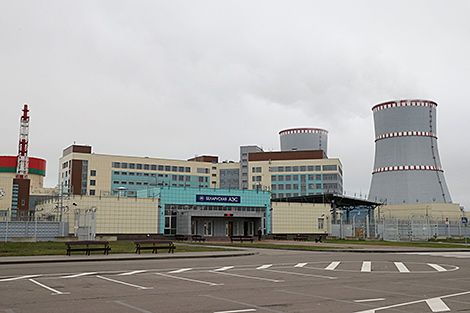Events
Safety of Belarusian nuclear power plant monitored in real time

An archive photo
MINSK, 22 February (BelTA) – The safety of the Belarusian nuclear power plant is monitored in real time. Head of the Radiation Safety Regulation Office of the Nuclear and Radiation Safety Department of the Belarusian Emergencies Ministry (Gosatomnadzor) Victoria Antonova made the statement in BelTA’s press center on 22 February.
Nuclear power plant safety control
In order to control the safe operation of the Belarusian nuclear power plant Gosatomnadzor has set up a center that takes care of informational, analytical, software, and technical support for regulatory activities. This center receives technical data and radiation data that describe the state of a reactor unit in real time. “We constantly see these figures and can guarantee that at present all the safety functions are normal,” Victoria Antonova stressed.
“Special working groups have been set up in order to constantly monitor these parameters. If an event involving the release of radioactive substances happens, our software can evaluate the radiation doses that the general public will get and can forecast the radioactive pollution of the territory. Wind direction changes, precipitation, and the terrain are taken into account,” the official pointed out.
In her words, apart from Gosatomnadzor a number of other government agencies are involved in this work. In particular, situation rooms have been set up in the Natural Resources and Environmental Protection Ministry and the Healthcare Ministry. No doubt the company in charge of operating the Belarusian nuclear power plant is responsible for most of the safety of the nuclear power plant, Victoria Antonova added.

Classification of nuclear power plant events
Gosatomnadzor representatives explained how various events that may happen at a nuclear power plant are classified. They talked about the relevant Belarusian regulations and international recommendations. “In order to understand the degree of danger of an event that happens at a nuclear power plant, it is important to have some classification everyone can understand. The International Atomic Energy Agency has been using the International Nuclear and Radiological Event Scale (INES) since 1990 in order to uniformly provide information about the significance of nuclear and radioactive events. This scale is applicable to any event relating to the transportation, storage, usage of radioactive nuclear materials and sources of ionizing radiation. It also includes the threat of a loss or theft of the relevant materials or sources,” Gosatomnadzor First Deputy Head Leonid Dedul said.
Events from level 1 to 3 are classified as incidents while events from level 4 to 7 are classified as accidents. Every level also includes the scope of impact on the general public and the environment. Radiological barriers and control, defense in depth are also evaluated. “The events, which are classified according to this scale, are in one way or another related to the release of radioactive substances, the irradiation of personnel or the population, the loss of control over sources of ionizing radiation. For instance, accidents at the Chernobyl nuclear power plant and the Fukushima nuclear power plant are classified as level 7. The radiation contamination accident at the enrichment plant Mayak was a level 6. Events, which are considered insignificant from the point of view of radiation and nuclear safety, are identified as fluctuations and classified below the INES scale (level zero),” the official said.
According to Leonid Dedul, the International Atomic Energy Agency recommends notifying neighboring countries about all events of level 2 and above within 24 hours. The approach allows promptly informing the general public about important events from the point of view of safety.
“In the past Belarus signed agreements on directly informing other countries, first of all, neighbors. These agreements touch upon possible accidents, upon the provision of information about the state of nuclear and radiation safety. We’ve voluntarily informed various countries about the transportation of nuclear fuel to the Belarusian nuclear power plant site, about the loading of fuel into the reactor, and about the launch of the reactor start-up. Although according to general requirements and IAEA practices we didn’t have to do it,” the official pointed out.
Head of Gosatomnadzor’s Nuclear Safety Regulation Office Vigen Marukhyan noted that Belarus had determined requirements for investigating and keeping records of violations in the operation of nuclear power plants. This document describes five categories of accidents and 10 categories of incidents. “An accident is an operation failure that involves the release of radioactive substances beyond the limits specified by design documents. An incident is a deviation from the normal operation due to equipment failures. Ways to respond to these events are stipulated by regulatory documents,” he stressed.







 print version
print version make home page
make home page add to bookmarks
add to bookmarks

